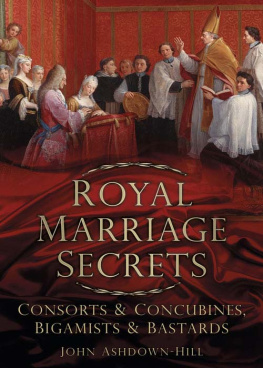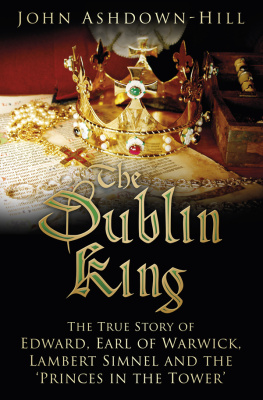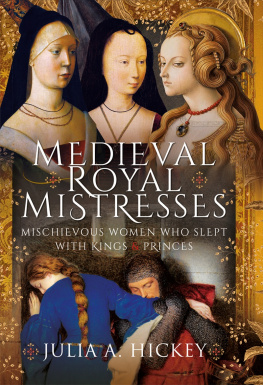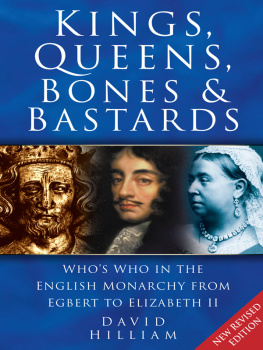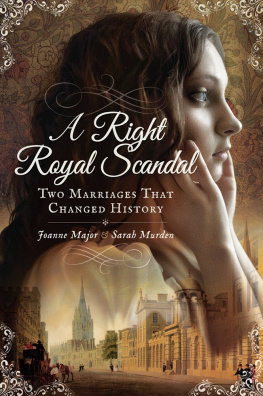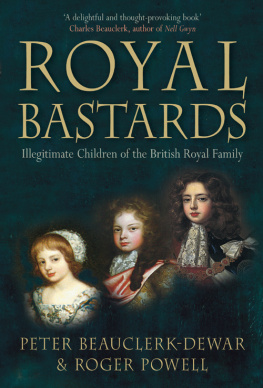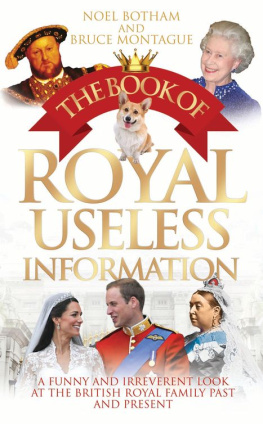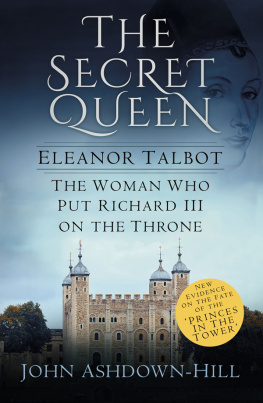In memory of my friend and colleague,
Dr Karen Tracy Yates-Sabren,
who read bits of it while I was working on it in Turkey,
and who had been looking forward to reading the whole thing.

Oh, tis a glorious thing, I ween,
To be a regular Royal Queen!
W.S. Gilbert, The Gondoliers

Such a lot of things are such rot.
History, for instance.
Why, its quite different out of different books!
Agatha Christie, The Moving Finger

C ONTENTS
I should like to thank Annette Carson and Dave Perry for reading and commenting upon draft versions of parts of the text. I am also grateful to Dr Alison Rowland for her advice on medieval love magic, and to Robert Galea-Naudi for his kind assistance with my researches in Malta.
There are three practical points to draw to the attention of my readers concerning the way in which names have been written. First, in the days before her marriage to the Prince of Wales, it always struck me as a little bizarre when the media referred to HRH the Duchess of Cornwall by the surname of her first husband, rather than calling her by her birth surname Camilla Shand. The practice of previous historians has often been inconsistent on this point. Some royal consorts, such as Elizabeth Woodville and Catherine Parr, are generally known by their maiden surnames, despite the fact that they had previous husbands. Others, such as Mrs Fitzherbert and Mrs Simpson, are generally called by their married surnames. But in genealogy and family history the normal practice is to refer to women by their maiden names. Therefore throughout this book womens maiden surnames are used consistently if these are known. Where their married surnames are more familiar, these are sometimes added in brackets in the text and they are cross-referenced in the index.
The second point is that in historical documents some first names occur in many variant spellings. Catherine, Catharine and Katheryn are good examples of this. Likewise Eleanor in medieval documents is often Alianore. I have tried to spell first names in one consistent way throughout. One exception is Isabel(le)/Isabella. Where this name refers to ladies of French origin the French spelling, Isabelle is used; for Spanish ladies, the Spanish form, Isabel. Isabella is only used for English ladies who were baptised with that form of the name. Of course, my selections reflect my personal choice and my spellings may not be everyones favourites.
Finally, sometimes royal names and/or numbers are given in square brackets as for example George [IV]. This is simply to show that at the date in question the monarch had not yet succeeded to the throne.
S ome historians argue that personal relationships are of little or no real importance in the course of history. I believe that they are wrong. Private emotions certainly affect people and when they are the emotions of people in power they can change the course of events. Moreover, royal sexual activity and royal marriage have always exerted a certain popular fascination, and they continue to do so to the present day. The mnage trois between the present Prince of Wales, his first wife Diana, and his mistress (later his second wife) Camilla, at times generated huge amounts of publicity. The marriage history of the princes siblings likewise that of his aunt, Princess Margaret also engaged considerable media attention at key periods.
Modern media interest in royal marriages particularly questionable royal marriages is often perceived to date back to the 1930s, and the relationship of the then Prince of Wales (Edward VIII) with his American divorcee, Bessie Wallis Warfield (Mrs Simpson) a drama which ended in marriage only after the kings abdication. However, eighteenth- and nineteenth-century press reports about George [IV]s relationship with the Catholic widow, Princess Fitz (Maria Smythe, Mrs Fitzherbert), and about Mrs Brown (referring to Queen Victorias reputed relationship with her highland ghillie, John Brown) show that there is a much longer history of public interest in such matters.
With only four or five (possible) exceptions Some kings married more than once. Many also had sexual partners outside their marriages. However, the number of English monarchs whose marriages have been a matter of dispute can be counted on two hands. Situations in which the identity of a sovereigns marriage partner was unknown or uncertain were normally ruled out by a natural concern for the succession to the throne.
Nevertheless, secret marriages have been reported or alleged in the case of eight English monarchs and one would-be monarch: Edward IV (reigned 146083), Henry VIII (reigned 150947), Elizabeth I (reigned 15581603), Charles II (reigned 166085), Charles III (never quite a monarch, but a famous royal figure, and the Stuart pretender to the throne 176688), George III (reigned 17601820), George IV (reigned 182030), Queen Victoria (reigned 18371901) and George V (reigned 191036). In addition to these nine cases, there have also been allegations of secret royal marriage relating to two heirs to the throne who died before they could succeed. One of these allegations is linked with a celebrated case of serial murder. It relates to George Vs elder brother, Albert Victor, Duke of Clarence. The other alleged secret marriage of an heir apparent relates to Edward IIIs son, the Black Prince.
Although we shall focus chiefly on these eleven cases, alleged secret marriage within the royal family as a whole is a more widespread phenomenon. The secret marriages of princes and princesses will provide a background and context for our exploration. Moreover, one case in the wider royal family the alleged secret second marriage of the queen mother, Catherine of France (widow of Henry V) is significant so it will be explored in some detail, focusing on possible new evidence.
In some of these allegations, religious issues are important. In particular the stories of the secret marriages of George [IV] and of Albert Victor, Duke of Clarence, to Catholic partners confront us with the discriminatory nature of the 1701 Act of Settlement. The provisions of this act still apply at the moment of writing. Recently it had seemed that things were about to change. In the Queens Speech at the opening of Parliament in May 2012 it was announced that the prohibition which prevents British royalty from marrying Catholics would soon be lifted. However, it now seems that the coalition government of Britain has dropped its plans for repealing the Act of Settlement. But for this act, of course, and other legislation affecting the royal succession, one of our cases of disputed royal marriage that of the Prince of Wales [George IV] with Maria Smythe (Mrs Fitzherbert) would undoubtedly have been legal. But this merely serves to reinforce the point that it is essential for us to be aware of precisely which marriage legislation was in force at the time when each of our disputed royal weddings is alleged to have taken place.
Six of the allegations against sovereigns involve the imputation of bigamy. This is most famously the case in respect of the future George IV. Another instance of bigamy can be detected (albeit heavily disguised by his own propaganda machine) involving Henry VIII. Further cases involving bigamy largely overlooked by posterity have been alleged in the cases of Edward IV, Charles III, George III and George V. These six instances of possible royal bigamy will all be examined and evaluated here.
Next page
